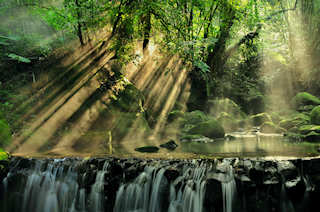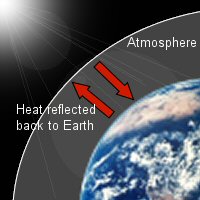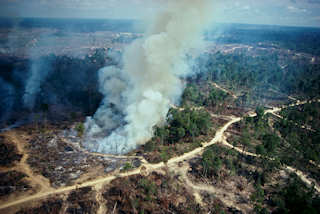It takes an average of 300-500 years for a tree to firmly establish its roots with a maximum height for some of the trees reaching 200ft - you can easily see why it takes this long and yet minutes to destroy. With the size of Wales being destroyed each year for products such as toilet paper, newspaper, writing paper and furniture, the forests are becoming more like deserts than the lush forests they once were.
Latitude and rainfall distinguish tropical forests from temperate (or moderate climate) forests which are found in warm climates but not too hot to be called tropical. Temperate forests are at ground elevation, mainly in North America, Europe and cooler Australasia. There are many types : deciduous woodland, coniferous woodland, Mediterranean woodland, mangrove and temperate rainforest.

All tropical rainforests lie between the Tropics of Cancer and Capricorn. They receive more water and temperature due to their location in the monsoon regions. There are many different kinds of tropical rainforest: tropical evergreen, tropical moist deciduous, cloud forest, lowland rainforest and peaty swamp forest.
Rainforests may grow in thin and sterile soil. This is achieved by ample sunlight and water, and nutrients from decaying plant matter. In the warm damp conditions, dead plants rapidly decay by bacterial or microbial action, releasing the nutrients.
The forests are a closed ecosystem where everything is recycled but once these forests are opened, the decaying matter is cleared, the moist conditions disappear and slowly the forest loses its ability to sustain itself.

Due to their precise positioning in the monsoon regions, the Rainforests attract heavy rainfall - but how does this help the climate? The Rainforests can absorb large quantities of carbon dioxide and emit oxygen into the atmosphere. The Earth's tilt also has a part to play in this. The Rainforests are situated in an area of the Earth which gets regular sunlight so they are very warm (and humid, due to the rain). As the rain falls in this region, it helps to cool the Earth.

To mention the Earth's tilt again. The Earth's tilt in axis of rotation is normally 23.5 degrees from the perpendicular to the orbit plane. But the Earth's tilt is out by 3 more degrees causing instability within the core. If this increases to 5 degrees then unpredictable results will happen. As you will read later, if all of the Rainforests are destroyed by 2012, then there is no way this catastrophic error can be corrected.
If the climate is affected due to warmer temperatures and changing wind patterns coupled with the disappearing forests, the rain is unlikely to fall in sufficient quantities in the right places that would cool the Earth. These areas would then be more prone to flash floods and mudslides where other areas would experience wildfires and drought. Remember what the Rainforests did for us - where's the carbon dioxide going to go? Where's the oxygen going to come from? Why are breathing-related diseases on the increase?
An interesting point can be raised here. What about the forests of Europe, USA and Canada? These are just as important to help maintain life on Earth but as they are primarily temperate forests (grow at higher latitudes), they do not attract enough water to cool the Earth. These forests are also under threat from logging corporations who do not use sustainable practices.
Scientists consider global warming as the effect on the temperature and climate of the Earth but does anyone consider the Earth's core?
As the crust and mantle are several thousand kilometres thick, what would the effect be? Imagine this...You are standing next to a central heating radiator - how long before the radiator's heat becomes too uncomfortable and you have to move?

If we apply this to the Earth.....
Sunlight is reflected back into space from the Earth's oceans and is trapped within the atmosphere by greenhouse gases. These gases are water vapour, carbon dioxide, nitrous oxide, ozone and methane which absorb heat, thereby warming the Earth. If there wasn't a natural greenhouse effect, the Earth's temperature would be -18 degrees Celsius instead of the present 14 degrees Celsius.
How long will it take before we see the effect?
It can be said that this situation will take years - OK, point taken. But how short a time will it be if the current estimates that we have until all of the Rainforests are destroyed and with them, our primary system for carbon dioxide absorption, oxygen supply and cooling of the Earth?
As the Earth becomes warmer, we will see evidence of more volcanoes, earthquakes, floods and unusual weather - just look at the News media. A semi-argument simmers. Surely this is the Natural Earth? Our answer would be that volcanoes that have lain dormant for years suddenly erupt without warning or unexpected earthquakes that hit cities or floods, outside the monsoon season, that kill thousands. It is only what we see that we can tell. If we do not act to stop the destruction of the Rainforests, the climate pattern known as El Nino will appear to be very inconsequential indeed.
The Earth's Temperature
The second point raised from our initial discussion, is of temperature increase. Scientists state that the global temperature will rise by 2.5 to 10.4 degrees Celsius (2016 was the hottest year on record) over the next one hundred years, on top of the one degree that we are experiencing now! (It is even stated that as the sea surface temperature gets warmer, El Nino climate patterns will become more intense and frequent).In next 5 years, will the current predictions still be true or will the global temperature increase by 5 degrees?? As we saw above, the Earth is getting warmer and this brings new problems. When the temperature increases, and the Earth's tilt changes, we have the danger that the polar ice caps will melt, thereby raising sea levels by hundreds of feet. Along with the mass extinction of animals and plants, the map of the Earth will be irreversibly changed.
Now as the polar ice caps melt, all of the frozen freshwater enters the conveyor belt system that circulates warm water around the Earth. The cold freshwater will dilute the warm salty water and effectively turn off this system. We will then experience an Ice Age.
Tree Frog (Hyla Boans), Leaf cutting Ant, Harlequin Beetle (Acrocinus Longimanus), Worker Ants, Gecko, Damselfly, Jaguar, Deer, Tapir, Rubber Fly, Coatimundi, Lanternwing Insect, Bull Frog, Red Squirrel, Anolis Lizard, Pike-headed Vine Snake, Red-eyed Tree Frog, Basilisk Basilliscus Americana, Helmeted Iguana, Boa Constrictor, Orange Tree Frog (Bojo Peregienes), Agalychnis Spurreli, Poison Tree Frog (Hyla Ebbraccata), Flaming Arrow Poison Frog (Dendrobates Pumilio), Hyla Boulanger, Aloreate Parrot Snake, Hummingbird, Bare-Throated Tiger Heron (Tigrisoma Mexicanum), Guatemalan Howler Monkey (Aloutta Villosa), Woolly Opposum, Baird's Tapirs, Wolf Spider, Tegnaria Spider, Katydid, Spotted Butterfly, Sphyngid Moth, Owl Butterfly, Winged Butterfly (Hypoleria), Clearwing Butterfly (Cithaerias Menander), Black Polister Wasp, Blackcurrent Grasshopper, Ruduvig Bug, Yellow Schegal Viper, Chrotopteris Bat, White Bearded Hermit Humming Bird, Apoica Wasp, Howler Monkey, King Vulture, Copybara (grows to 4feet and is the largest living rodent), Ocelot, Giant Otter, Hoatzin, Orgiope Argentata, Pygmy Anteater (Cylcopes Didactylus - rarely grows more than 7inches), Dendrobates Leucomeless, Eleuthero Dactylus, Caterpillar, Amazon Dolphin, Red Faced Uakari (Cacajao Rubicundus), Woolly Monkey (Lagothrix Lagothricha - woolly monkeys live with up to 50 other individual monkeys), Two Toed Sloth (Choloepus Didactylus), Blue Morpho butterfly (Morpho Nestira),

Dung-Eating Butterfly, Sulphur Butterfly (Phoebus sp - sucks moisture from the riverside mud of Bolivia), Actinote Momina Butterfly, Grasshopper, Urticating Caterpillar, Bird-Eating Spider, Piranha, Green-Throated Hummingbird, Yellow Rumped Cacique (Cacicus Cela), Fruit-Eating Bird (found in large groups), Blue-Tailed Emerald Hemmingbird (Chlorostilbon Melliscus), Genus Ithomiidae, Heliconid, Heliconius Melpomene, Cattle Egret (Ardeola Ibis), Long-Tailed Lemur (Lemur Catta), Black Lemur (Lemur Macaco), Indris (Indri Indri - largest of the lemurs growing around 28 inches), Aye-Aye (Daubentonia Madagacariensis), Toco Toucan (Ramphastos Toco), Red-Ruffed Lemur (Lemur Variegatus-Ruber), Pygmy Hippopotamus (Choeropsis Liberiensis), Eastern Lowland Gorilla, Silverback Ape, Leopard (Panthera Pardus), Tiger (Panthera Tigris - largest hunter of the rainforests, reaching over 11 feet), Spoonbill (Platgala Leuxorodia), Stork (Ibis Leucocephallus), Genus Cynapes Spider,
Tocrue Macaque Monkey, Brown-Headed Barbet, Purple Sunbird (Cinnyris Asiatica), Paradise Flycatcher (Terpsiphone Paradisi), Ceylon Hawk, Malabar Pied Hornbill, Ceylon Serpent Eagle, Silvered Langur, Stump-Tailed Macaques (Macaca Fascicularis), Malay Fishing Owl, Adjutant Stork, Flying Frog, Praying Mantis, Flying Foxes, Viper, Python, Golden Tree Snake, Siamang (Large Gibbon), Blue-Eared Kingfisher (Alcedo Meninting), Heron, Weaver Ants (Oecophylla Smaragdina), Thosea Butterfly, Paper Wasp (Polistes), Atlas Moth (Attacus Atlas), Two Horn Rhino Beetle, Blue-Throated Bee-Eater (Merops Viridis), Rufous-Backed Kingfisher, Jumping Spider (Hyllus sp), Orang Utan (Pongo Pygmaeus - grow as tall as 5 feet), Asian Rhinoseroses (once found throughout Java and mainland Malaysia but hunting has reduced its numbers to a few hundred), Blossom Bat, Giant Wood Spider (Nehila Maculata), Harpy Eagle, Tree-Dwelling Anteater (Tamandua), 12 inch Golden Conue, Giant Anole Lizard.
Plants and Flowers
Bosleria Orchid, Wild Fuchsia, Aroid Plant, Gurania Climber, Cephaelis Alata, Forest Mistletoe, Ginger Flower, Epidendron Orchid, Pseudobombax Flower, Helicona, Purple Helicona, Red and Green Helicona, Passion Flower, Black Lilly, Climbing Palm (Calamus Densiflora), Sobralia Orchid, Sonneratia Flower, Black Pomatocalpa Orchid, Chloranthum Orchid, Bulbophyllum Orchid, Ladies Slipper Orchid (Glaucophyllum), Pink Orchid, Helliconia Collinsiana, Sumatran Orchid, Wild Ginger Plant, Pholidota Imbricata Orchid, Mucuna Novaeguineesis.Medicines
It is astonishing to think that of the drugs we use today, most of the common ones are derived from plants in the rainforests - more astonishing is that only a small amount of the plants have been screened for medical use. The following is a list of drugs that the plants have provided a basis for: the contraceptive pill, antibiotics, tranquillisers, dental cement, heart and ulcer drugs.In fact one in four products from the chemist contain chemical compounds derived from rainforest plants. 70% of anti-cancer plants originate from the rainforests and the US National Cancer Institute identified 3,000 plants with properties in fighting cancer.
From 1960-1990, the survival rate for child leukaemia rose from 20% to 80% when 'The Rosy Periwinkle' plant from Madagascar played a major contribution in fighting this form of cancer. The Cinchona tree from Peru has been effective in treating malaria; the Guatemalan wild yam is a major contribution to the effectiveness of the contraceptive pill; Resperine from South East Asia, from the shrub Rauwlfia Serpentina is used for treating hypertension. Cement used in dentistry comes from the balsams of Latin America. The 'Benzoin Tree' of Malaysia produces a yellow substance that is used for antiseptic and to treat bronchitis. This is the Earth's own medicine cabinet with many more cures for illnesses hidden within the forests.
With the pharmaceutical companies making billions in profits each year, it seems that it is in their interest that the forests no longer survive, but the forests provided the basis for all of man's drugs and we should start preserving them now.
Timber Industry
Trees are logged both legally and illegally to supply the timber trade. The industry is worth billions as the insatiable demand for wood in Japan, Europe and USA grows. There are governments who sell acres of forests to companies for a pitance in the premise that local workers are employed. Other governments have even offered their forests as payment for weapons!In South America, in particular Brazil, criminal gangs have entered protected Indian reservations and felled trees. These are then passed into the market with false certification. Greenpeace and Friends of the Earth have been instrumental in making the World aware of this problem. Yet, the problem still exists in other countries/areas such as South East Asia. Even Russian temperate forests are suffering due to the demand for timber from Japan.
Now consider the impact of a tree being felled. Despite noise pollution from the chainsaw, the tree falls to the ground, striking surrounding trees. Wildlife is disrupted, plants are destroyed; the ecosystem is wounded. In Vietnam, soldiers were pelted with stones as they tried to prevent villagers from illegally logging trees.
Mining
Corporations have bought mining rights to areas of forest so they can drill for diamonds, gold and other precious minerals. The workers who get paid a pittance are just as much losers as the trees. The ecosystem suffers terribly as chemicals that are used to clean and lubricate drill bits, are washed into the rivers, polluting and killing everything it touches.
Oil and Gas Exploration
With our thirst for oil at an all-time high, corporations are buying up prospecting rights in the forests. After a location has proved valuable enough, the drilling rights are sold and more trees are felled with wells being erected in the pursuit of 'liquid gold'. For all the reasons that mining destroys the forests, oil and gas exploration are the same.Paper Industry
There are conflicting views about whether trees are specifically felled to supply the paper industry. Moreover, after trees are felled for the timber industry (for furniture, building materials etc), they are cut and whatever is discarded from this process is put through a chipping machine (for bark chippings for gardens) or made into pulp. This pulp is then used in the manufacturing process of paper. Any smaller trees that are felled during the extraction of the larger trees are used for paper. The reason - wood is used as virgin pulp to make paper whiter and stronger as DEFRA, the UK agency, reports that paper can only be recycled so many times before the structure of the paper breaks down.Farming
Trees and the ecosystem are savagely attacked by farmers using 'slash and burn' techniques. Areas of forest are cleared by fires in the view that the lush ecosystem that exists, and the ash from the burning trees, will provide fertile soil for crops. This is true but it is only for a year when the rains will wash the nutrients and the soil away. The farmers then move to another area and continue the process. The fires in Indonesia in 1998 were blamed on farmers and despite millions of acres of rainforest being destroyed, and South East Asia being blanketed in a thick smog for a few months, no-one was prosecuted. The pollution from this sitiuation had consequences as heavy rains turned the hills into deadly mudslides.It now seems the largest problem facing the rainforest ecosystem is from soya and palm oil farming. The former product is primarily used for cattle feed, where as the latter is used in the food and cosmetic industry. Millions of tonnes of soya are grown with the intention of feeding animals - surely this could be grown elsewhere or is it the low price that attracts so many Western countries to purchase from the likes of Brazil?
Is it really worth it just to grow - unsustainably - bananas, cocoa, coffee, rubber and palm oil? If you buy any of these products then make sure they are Earth-friendly, for you could be unwittingly helping to contribute to the demise of the forests.
Cattle Ranching
Land is cleared in much the same way as above, and cattle are sent to graze. This cattle are used to supply the multi-billion dollar beef industry in the US and Europe in which Brazil is increasing its share. We received information from Aloke Barua who had been researching this subject. One article was by Ronald Cummins who presented a case for The Environment against the main US burger companies who were/are part of the 'Hamburger Connection' which was threatening Costa Rica and Guatemala.From Ronald's CV, he is well qualified on Costa Rica & Guatemala and investigative journalism. He found that McDonalds and Burger King while claiming to support rainforest preservation and maintaining that they buy no hamburger meat from recently deforested areas, they were an integral part of an industry that if left unchecked threatened to destroy rainforests in Central America. He quoted a statement from a journalist for the UK newspaper, The Observer, that quotes McDonalds as saying they would not buy beef from rainforest areas that were deforested within the previous 10 years (their policy to 1988) or 25 years (their policy from 1989).
He notes that meat imported into the US from rainforest areas is mixed with domestic meat in processing plants, and McDonalds admits that they were complicit in destruction prior to 1988.
Ronald further states that 10 or 25 years is not enough for a rainforest to regenerate naturally. He found that US companies such as Cargill, Iowa Beef Processors and Con-Agra, use alternative suppliers in Argentina, Central America and Australia as blackmail to keep prices that they pay to US ranchers as low as possible - yet the US domestic market produces a surplus! Since 1984 in Guatemala, he observed farmers moving from deforested land and ranchers moving in. In this way, neither the rancher or the US company will accept any blame for felling the trees.
Ronald suggests, along with RAN, that the only policy to preserve the rainforests is to ban all beef imports from countries containing rainforests.
(Thanks to Aloke Barua for supplying this information and thanks to Ronald Cummins for his excellent work)
Relevant News:
4th Apr 2025
30th Mar 2025
21st Mar 2025
26th Feb 2025
17th Feb 2025
22nd Jan 2025
14th Jan 2025
27th Nov 2024
18th Nov 2024
12th Nov 2024
For news from previous years, see the News Archive.

Forests that are burnt will not return again as the ground is not fertile enough and nothing will grow; it will be like a house gutted after a fire. Something that has taken thousands of years to grow, cannot return in the time needed to save the planet. The forests normally receive up to 200 centimetres of rain a year but this will soak into the ground and flood the area causing mud and land slides.
In 1988 the great floods of Thailand alerted the government of the dangers and implications of forest clearing. A study carried out in the Ivory Coast region found that in a landslide, a forested slope lost 0.03 tons per hectare per year where as a deforested slope lost 138 tons of soil per hectare per year. You can also add the levels of carbon dioxide that are released into the air when forests are burnt.
Based on a 1992 study, figures showed 15-20% of carbon dioxide was emitted into the air and ten years later, you can double that and then add the emissions from the Industrial Age and fossil fuels and that the percentage gets higher and higher. As the forests continue to be destroyed and emissions are not cut drastically, we will see such diverse weather patterns like never before with famine, drought and disease, extreme flooding and this is only the beginning...
Despite the fact that decisions are made by governments, you the people, can make a difference. Visit Change.org and search for petitions about the palm oil, illegal logging, forest fires etc - see below. Change.org is seen by thousands of people and can make a difference. Use our list of World Leaders and pressure them through legal means, to ask for a moratorium on logging and rainforest destruction.
Donate money to environmental groups to support their work in rainforest protection - make sure that your donation directly goes to support your chosen action.
Petitions:
EU: Ban Forest-Killing Products!
Stop the burning of the Amazon rainforest!
Kellogg’s: Stop destroying rainforests for cheap palm oil!
RAN Action - BRANDS & BANKS: DISCLOSE YOUR IMPACTS!
2) Recycled Paper
Ask your company or paper suppliers to switch to paper made from post consumer waste. In the USA, students forced their University to drop Staples as a supplier because they didn't sell recycled paper. With pressure from RAN and grass-roots activists, Staples have announced they will be stocking recycled paper.
3) Encourage better practices in Land Management
If farmers were given improved training in land management, then better use would be made of existing agricultural areas.
4) Sustainable Forestry
Villagers in one country were given control of their neighbouring forest. As they depended on the forest for their survival, the trees were sustainably felled and sold for money for the village. In this way, the ecosystem was allowed to rejuvenate. Sustainable forestry can work and does work - only buy wood from sustainable sources. Use sustainable and certified wood in projects and building. Even better, find and use discarded wood which has been recycled.
5) Cattle Ranching
If cattle is used to supply the beef industry, then it should not graze on deforested land, whether 10 or 25 years ago. Fast food companies should act responsibly and should prove that they do just this.
2) Support and join environmental groups and campaign to save existing woods and forests.
3) Help to plant trees in your area. Scientists have reported that planting billions of trees could remove enough carbon dioxide from the atmosphere and help to bring climate change under control - see Tree planting 'has mind-blowing potential' to tackle climate crisis.
4) Start recycling. Speak to your council about recycling facilities. Paper, cardboard, plastic bottles, glass, cans and wood can be recycled. Use recycled paper and recycled toilet paper - the more we use, the cheaper it becomes and companies will change their policies due to our societal pressure. And importantly, recycle responsibly - it is your task to put it in the bin correctly.
5) Re-use plastic bags. It takes over 30 years for one plastic bag to biodegrade. This means in our present environment with millions of plastic bags everywhere, we will still see ones in our sixties that we used when we were teenagers! Take your own bags to the shops so if anyone asks if you want a plastic bag, refuse and fill your own. Encourage supermarkets to stop the free supply of plastic bags, use cardboard boxes which can be recycled more easily.
6) Use electronic communications and non-paper learning resources.
Article References
The Green Guide by Angela Smyth & Caroline Wheater
Tropical Rainforests of the World by Rupert O. Matthews
Battle For The Planet by Andre Singer
